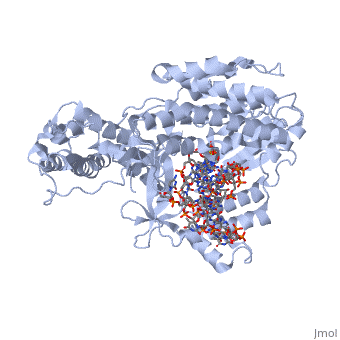Telomerase
From Proteopedia
(Difference between revisions)
| Line 1: | Line 1: | ||
<Structure load='3kyl' size='350' frame='true' align='right' caption='Telomerase: bound to telomeric DNA [3kyl]' scene='Insert optional scene name here' /> | <Structure load='3kyl' size='350' frame='true' align='right' caption='Telomerase: bound to telomeric DNA [3kyl]' scene='Insert optional scene name here' /> | ||
== Introduction == | == Introduction == | ||
| - | + | The telomerase is a complex composed of an RNA primer and protein that adds repeated DNA sequences to a 3' DNA strand. This ribonucleoprotein acts as a reverse transcriptase that creates a DNA sequence complementary to its RNA primer in its catalytic subunit, TERT. The sequences attached to the end of DNA is non-coding DNA that functions as protection from mutation and degradation. As DNA replications occurs, the polymerase that copies in the 5' to 3' direction, cannot copy the end of the lagging strand which leaves unpaired bases that may code for a specific gene. Multiple unpaired ends can form hydrogen bonds or even swap genetic material. The telomerase fixes this issue and lengthens the strands, because the replication process slowly shortens the ends of chromosomes. This enzyme also plays a role in coordinating cell division. Complementary issues of aging and cancer describe the inactivation or over-activation of telomerase activity. | |
| - | + | ||
== History == | == History == | ||
Revision as of 21:06, 11 October 2014
|
Contents |
Introduction
The telomerase is a complex composed of an RNA primer and protein that adds repeated DNA sequences to a 3' DNA strand. This ribonucleoprotein acts as a reverse transcriptase that creates a DNA sequence complementary to its RNA primer in its catalytic subunit, TERT. The sequences attached to the end of DNA is non-coding DNA that functions as protection from mutation and degradation. As DNA replications occurs, the polymerase that copies in the 5' to 3' direction, cannot copy the end of the lagging strand which leaves unpaired bases that may code for a specific gene. Multiple unpaired ends can form hydrogen bonds or even swap genetic material. The telomerase fixes this issue and lengthens the strands, because the replication process slowly shortens the ends of chromosomes. This enzyme also plays a role in coordinating cell division. Complementary issues of aging and cancer describe the inactivation or over-activation of telomerase activity.
History
Structure
Active Site Chemistry
This is a sample scene created with SAT to by Group, and another to make of the protein. You can make your own scenes on SAT starting from scratch or loading and editing one of these sample scenes.
</StructureSection>

